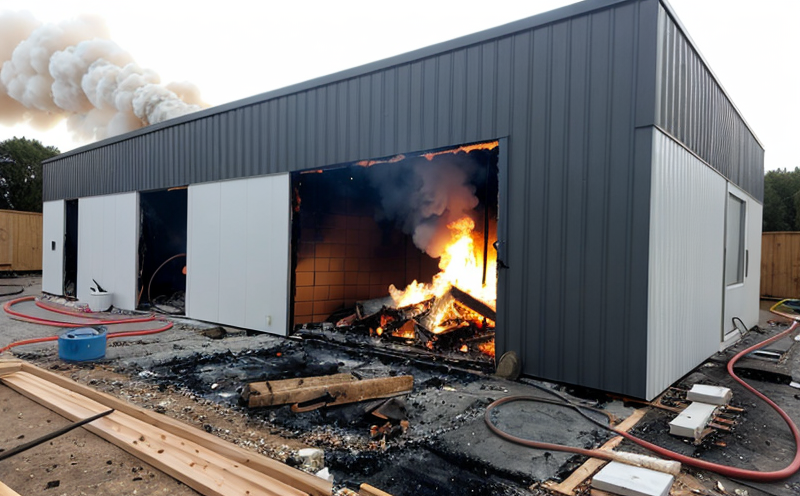Fire Resistance Testing of Insulation Layer in Sandwich Panels
The fire resistance testing of insulation layers within sandwich panels is a critical aspect of ensuring building and structural integrity during emergencies. This service ensures that the insulation material, which typically constitutes a significant portion of the overall weight and thermal performance of these panels, meets stringent fire safety standards.
Sandwich panels are widely used in construction due to their excellent insulating properties and load-bearing capabilities. The insulation layer is made from materials such as polyurethane foam, mineral wool, or expanded polystyrene (EPS), which must be tested for their ability to resist fire spread under specified conditions.
The testing process involves subjecting the specimen to a controlled flame for a set duration and observing its behavior. This includes monitoring factors like flame propagation rate, heat release rate, smoke production, and structural integrity retention. Compliance with standards such as ISO 834:2015, ASTM E136, or EN 13823 ensures that the insulation layer performs optimally in real-world scenarios.
For R&D engineers, this testing is crucial for optimizing material composition and structure. Quality managers can use these results to ensure product safety throughout production, while compliance officers rely on such data to meet regulatory requirements. Proper testing also supports procurement teams by validating supplier claims of fire performance.
The process typically involves preparing a representative specimen of the insulation layer according to specified dimensions and thickness. The sample is then placed in a furnace where it is exposed to a standard flame source for a defined period. The apparatus used includes a calorimeter, temperature sensors, and smoke detectors to measure various parameters during testing.
After the test, detailed reports are generated documenting the observed behaviors and compliance with relevant standards. These reports serve as essential documentation for certification purposes and help stakeholders make informed decisions regarding product development and quality assurance.
Benefits
- Enhanced Safety: Ensures that buildings comply with fire safety regulations, thereby protecting lives in case of emergencies.
- Improved Product Quality: Provides detailed insights into the performance characteristics of insulation materials under fire conditions.
- Simplified Compliance: Helps clients meet international standards like ISO and ASTM, reducing the risk of non-compliance penalties.
- Cost Efficiency: Identifies potential issues early in the development process, avoiding costly reworks or recalls.
Environmental and Sustainability Contributions
Incorporating fire-resistant insulation layers into sandwich panels not only enhances safety but also contributes positively to environmental sustainability. By using advanced materials that pass rigorous fire tests, buildings can achieve higher levels of energy efficiency while maintaining structural integrity. This approach supports the development of greener construction practices and promotes sustainable urban environments.
The use of recycled insulation materials or those with low embodied carbon footprints further enhances these benefits. Fire resistance testing ensures that these eco-friendly choices are reliable and performant, aligning with broader sustainability goals in the industry.
Competitive Advantage and Market Impact
- Market Leadership: By offering comprehensive fire resistance testing services, laboratories can position themselves as trusted partners for construction companies aiming to comply with stringent safety standards.
- Innovation Support: Providing state-of-the-art facilities and expertise helps clients stay ahead of regulatory changes and industry trends.
- Certification Assurance: Ensuring products meet international standards can open new markets and enhance brand reputation.





